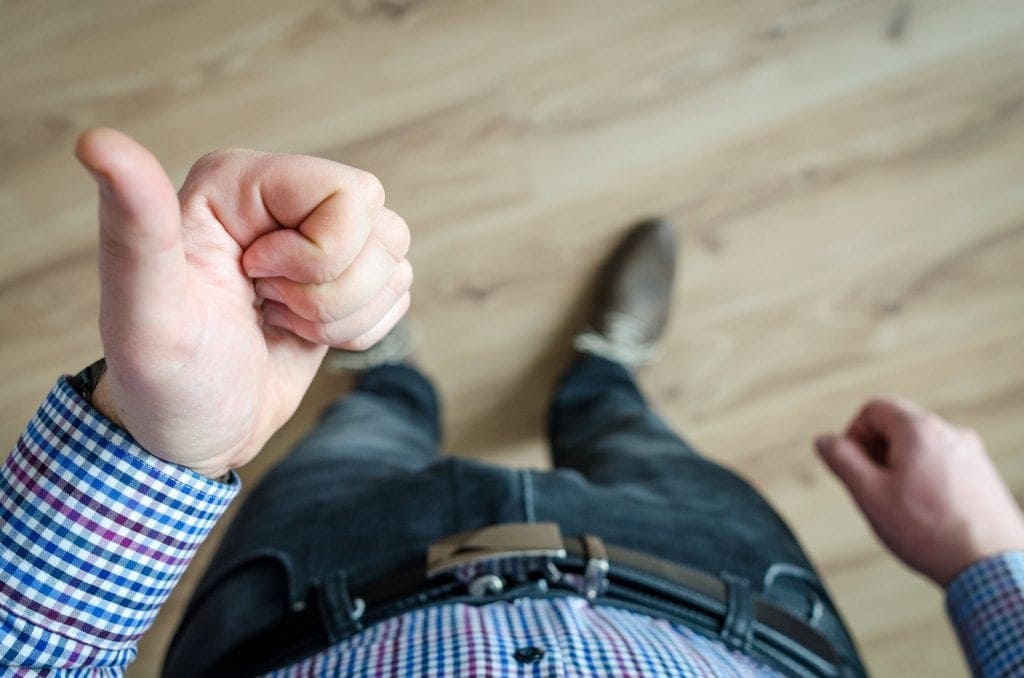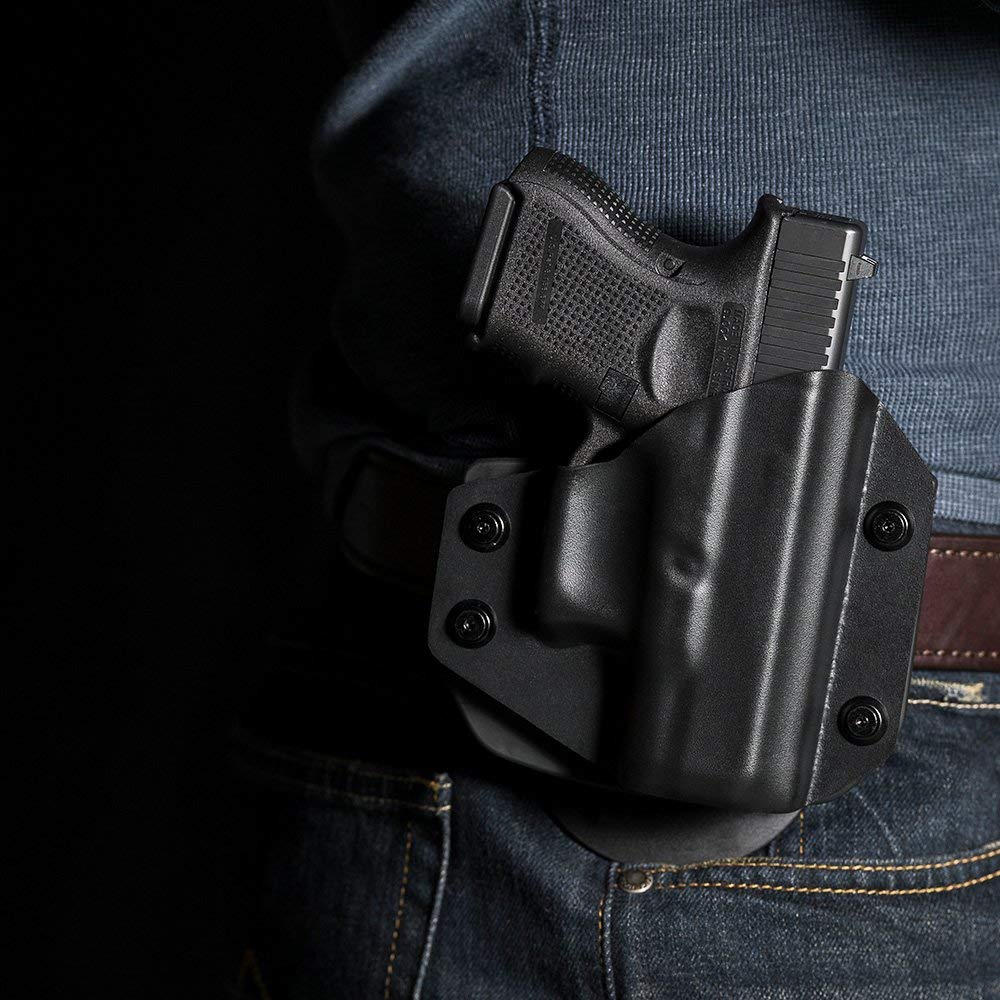A paddle holster is just an OWB holster combined with a paddle for an easy and secure attachment to your waistband. To use a paddle holster properly and effectively, you must learn how to wear it and make proper adjustments so it stays comfortable and ready.
You must also know the advantages and disadvantages of using a paddle holster, so it may help you decide when to use it and when not.
Here you’ll be reading about all these factors to learn the ins and outs.
Preparing for a Paddle Holster
Before you can use a paddle holster, you must carry out certain steps to ensure you are prepared properly. This procedure has two sections.
First to prepare the weapon and second to prepare the holster. To make it simple, let’s break it into a step by step procedure:
- Choose an appropriate weapon: If you are preparing for concealed carry, use a smaller subcompact type handgun or any other handgun of your preference will work fine. If you want to use a long-barrelled handgun, you must carry the holster higher on your waist.
- Check the safety: Before performing any further steps, make sure the weapon is safe to use. Either do a finger check or if you want to work with a loaded pistol, make sure the safety is on and the gun isn’t charged. Remember, safety is the first priority when working with firearms.
- Setup the holster: While some designs are fully functioning paddle holsters, some have a modular structure to allow switching. In case you have to change the belt attachment and install the paddle to your current holster, use the user manual of your holster and the appropriate tools to perform this operation.
- Keep the weapon aside: Push the gun inside the holster to check if it gets seated properly. Once you confirm this, put the weapon aside.

Alien Gear Holsters Cloak Mod OWB Paddle Holster
Wearing Paddle Holsters - What You Need to Know
Before you start using a paddle holster, there are certain things you need to know. These factors not only affect the effectiveness of the holster but also your comfort and performance.

Always Use a Belt
Paddle holsters work on the concept of friction for providing retention.
You can use a one without the belt by just clipping it to the waistband of your concealed carry pants.
But using a gun belt will prevent your holster from pulling out. Since the belt provides a raised contour for the paddle to snag into when you apply an upward force to draw the weapon.
Additionally, a belt helps keep your pants from sagging under the weight of the holster and the handgun.
Carry Angle
Most paddle holsters offer an adjustment for cant. It is a bit inclined outwards to offer a good grip over your weapon.
To make it even more effective, you should carry your weapon at the FBI cant (15 degrees forward).
When carrying the holster vertically downwards, you first have to pull the weapon up, and then swing your arm towards the target.
However, when carried on a cant, you eliminate this extra ‘ up’ movement and aim a bit more quickly over the target.

Law enforcer using a paddle holster (Source)
Ideal Situations: Paddle holsters are ideal for tactical uses as well as everyday concealed carry(EDC).
Tactically, they offer a better grip on the weapon and a quicker draw time compared to IWB holsters. That’s why law enforcement officers use it often.
Additionally, when coupled with appropriate clothing like jackets or untucked loose shirts, paddle holsters can be concealed easily.
Plus, you can also slide and adjust the position of these holsters when you walk, sit, bend, drive, or run.
Practice: Always remember that practice makes perfect. You must practice very often with your holster to ensure you react properly when you need it.
How To Wear and Adjust a Paddle Holster
Using this video demonstration, you’ll learn to make appropriate adjustments. The holster used in the video for reference is the Alien Gear Cloak Mod paddle holster. You will learn to switch between the paddle and the belt attachment.
Additionally, it shows how to adjust the cant and retention of the holster. You also learn the process of changing the holster shell in case you need to use a different firearm with the same paddle.
Finally, you will get to know about the process of wearing and adjusting the holster, along with info about the possible and best positions to carry.
Paddle Holster Retention
Like other holster types, these holsters also offer two types of retention; Active and passive.
Passive retention relies upon the friction between the holster and the weapon. In some holster types like the leather holsters, the retention entirely depends upon the size of the holster, its inner surface, and its ability to be broken in.
However, in some, passive retention can be adjusted using retention screws on the holster. Holsters with passive retention are generally open-ended.
Now in regards to active retention, they use extra mechanisms to secure the handgun in place.
Some commonly used active retention mechanisms are thumb straps, push buttons, Velcro based holsters, twist locks, etc.
Active retention ensures that the gun won't fall out of the holster under any circumstances. Like when walking, running, bending or doing any other strenuous activity.
It is always better to choose an active retention holster over a passive one, especially when carrying an OWB.
Some holsters use a combination of active and passive retention. Most holsters on the market use such retention. This is also known as level 2 retention, where the handgun is secured by a combination of active and passive retention.
Moving further, certain manufacturers have also come up with level 3 retention holsters which use one active and two passive retention mechanisms.

SERPA CQC Concealment holster features Level 2 retention, passive (Source)
Advantages and Disadvantages of Paddle Holsters
Like any other holsters, paddle holsters too have their set of advantages and disadvantages. Lets look into the details.
Advantages
Easy to Remove: It can be easily removed by simple clipping it out of your waistband. This feature makes it handy for law enforcement officers or people who need to switch between holsters. You also don’t have to undo your belt or pants or make any other wardrobe related adjustments to remove these holsters.
Easy to Adjust: To adjust the carry position, all you have to do is to slide it where you want it positioned. This allows you to change its position appropriately when you sit, walk, or do any other activity.
Concealment with Comfort: They can be removed when needed and adjusted easily for their carry position. These factors make them very comfortable to use. Plus, they are also easy to conceal when used with appropriate clothing, which also makes them good for everyday concealed carry.
Quick Draw: Being used as OWB, they also offer a quicker draw time when compared to other holster types such as tuckable holsters. These holsters are easy to reach, provide a firm grip on your weapon, and let you aim at the target within the quickest time possible.
Disadvantages
Not Very Secure: A paddle holster can be pulled out of your belt if some extra force is applied. If the holster is not worn properly or someone tries to snatch your gun, the holster might come out. This makes it prone to snatching, unlike IWB and belt loop holsters.
Limited Concealment: Although a paddle holster can be concealed with ease, it also limits your wardrobe and concealed carrying space to some extent. You always have to wear an untucked loose shirt or any covering garment like a coat or jacket in order to conceal it.
Large Size: They are larger in size, which might create problems with concealment and carrying. These holsters may also not be very comfortable for very slender people.

Conclusion
Paddle holsters are worn OWB and are exceptionally good for tactical and range use, along with everyday carry.
Paddle holsters can be easily removed when needed, and are easy to adjust by sliding them over the belt. They can have active or passive retention, and choosing it is a matter of your personal discretion.
Paddle holsters are comfortable, offer a quick draw, and can be concealed easily with proper clothing.


